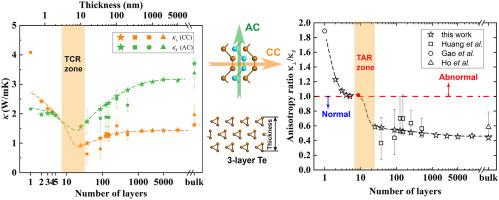Materials Today Physics ( IF 10.0 ) Pub Date : 2022-07-08 , DOI: 10.1016/j.mtphys.2022.100776 Yanhua Cheng , Jinlong Ma , Yaxin Xu , Guoqing Sun , Xiulin Ruan , Xiaobing Luo

|
Tellurene (Te) has attracted tremendous interest due to its outstanding electronic, thermoelectric, and optoelectronic properties. Recently, it is found that 2-layer Te exhibits an abnormal anisotropy of in-plane thermal conductivity. This inspires the current investigation, where the thickness dependence of in-plane thermal conductivities of tellurium from 2D to 3D is obtained by first-principles calculations and Monte Carlo simulations. Two intriguing phenomena are discovered: (1) Thermal conductivity rebound (TCR), i.e., the thermal conductivity first reduces and then increases with the increasing thickness. The predicted lowest point emerges between 6-layer to 15-layer; (2) Thermal anisotropy reversal (TAR), i.e., the in-plane thermal conductivity anisotropy reverses from abnormal (κ⊥/κ∥ > 1) to normal (κ⊥/κ∥ < 1) with increasing thickness. The predicted reversal point occurs at around 7-layer. To understand these phenomena, the frequency- and mode-dependent analyses on phonon group velocity and relaxation time are performed. As the thickness increases, the relaxation time almost monotonically increases, whereas the velocity of low-frequency optical (LFO) phonons shows the same varying trend with thermal conductivity, making it the main factor accounting for the TCR and TAR. The trend of the group velocity of LFO phonons can be attributed to the lattice expansion, which diminishes the covalent-like quasi-bonding (CLQB) in the cross-chain direction. The layer-dependent thermal transport of Te revealed in this work is expected to provide guidance for Te-based functional devices, for instance, the thermoelectric system where the lowest thermal conductivity is favorable.
中文翻译:

碲平面内热传输从 2D 到 3D 的演变
碲烯 (Te) 因其出色的电子、热电和光电特性而引起了极大的兴趣。最近,发现 2 层 Te 表现出面内热导率的异常各向异性。这激发了当前的研究,其中碲的面内热导率从 2D 到 3D 的厚度依赖性是通过第一性原理计算和蒙特卡罗模拟获得的。发现了两个有趣的现象: (1) 导热系数回弹(TCR),即导热系数随着厚度的增加先减小后增大。预测的最低点出现在 6 层到 15 层之间;(2)热各向异性反转(TAR),即,面内热导率各向异性由异常(κ⊥ / κ∥ >1)反转为正常( κ⊥ / κ∥) < 1) 随着厚度的增加。预测的反转点出现在 7 层左右。为了理解这些现象,对声子群速度和弛豫时间进行了频率和模式相关的分析。随着厚度的增加,弛豫时间几乎单调增加,而低频光学(LFO)声子的速度随热导率的变化趋势相同,使其成为TCR和TAR的主要因素。LFO 声子的群速度趋势可归因于晶格膨胀,这减少了跨链方向上的类共价准键(CLQB)。在这项工作中揭示的 Te 与层相关的热传输有望为基于 Te 的功能器件提供指导,例如,











































 京公网安备 11010802027423号
京公网安备 11010802027423号